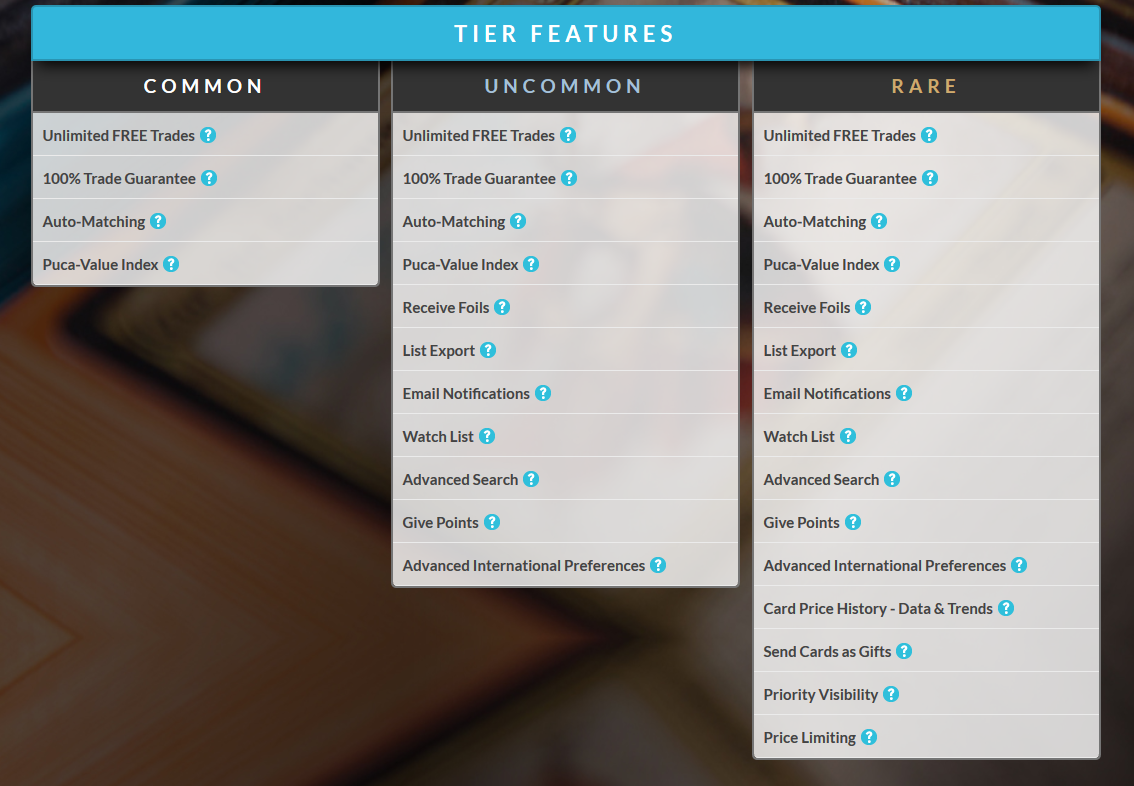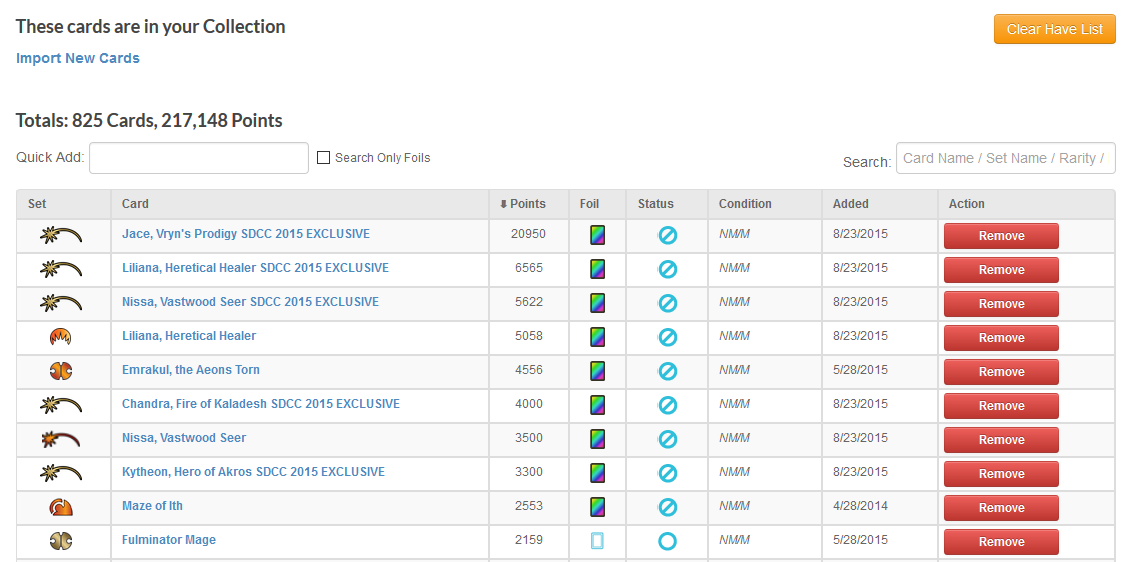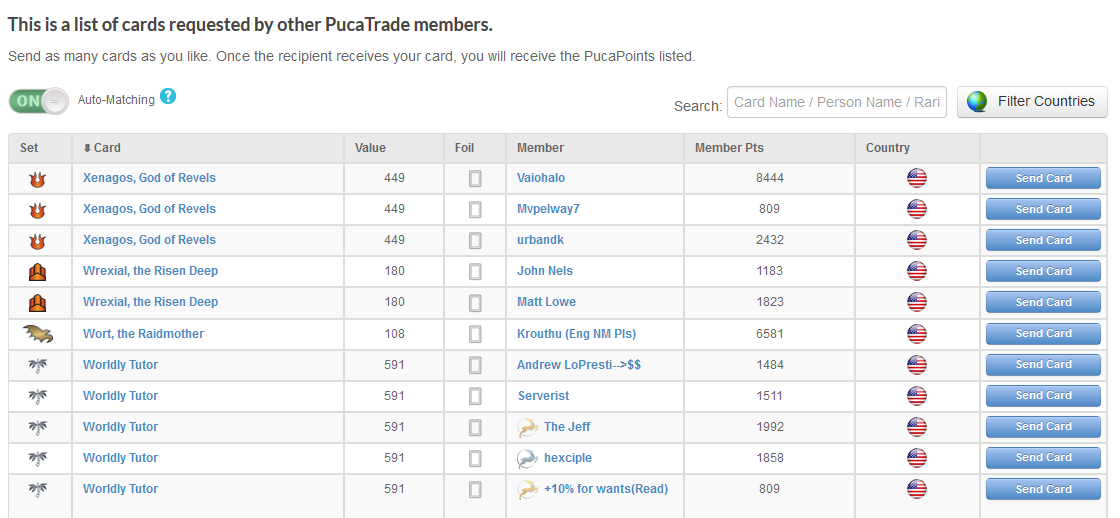Are you a Quiet Speculation member?
If not, now is a perfect time to join up! Our powerful tools, breaking-news analysis, and exclusive Discord channel will make sure you stay up to date and ahead of the curve.
Hello! This is Steve Horton. I'm a marketing manager by trade, write comics professionally, and play a lot of Magic. Today kicks off a series I'll be writing for Insiders on mastering PucaTrade.
I've been using PucaTrade effectively since it started, and I've learned a few things about how to maximize value with this revolutionary trading service. Over the course of the series, I'll explain how to rid yourself of what you don't want, gain what you do want, and increase the value of your collection in the process.
A New Way to Trade
 In the Stone Ages, in order to trade Magic cards through the mail, there had to be a certain level of trust involved. A few sites tried to facilitate this with reputation management, to varying degrees of success.
In the Stone Ages, in order to trade Magic cards through the mail, there had to be a certain level of trust involved. A few sites tried to facilitate this with reputation management, to varying degrees of success.
There would always be cases, though, where one person would get their cards, and the other wouldn't, or there'd be a dispute over condition, or printed language, or version. It became such a huge hassle that trading mostly remained a local phenomenon, or players simply gave up and bought the singles they needed.
Enter PucaTrade. (Note: This first link is affiliate-free, but all further Puca links will have the author's affiliate link attached.) This tool has been around for a couple years, but it only recently exploded in popularity, having processed its three-millionth confirmed trade. PucaTrade works on an asynchronous point system. That sounds like a mouthful, but here's a simply-worded explanation for how it works.
PucaTrade Step by Step
- You post the cards you have for trade under Haves, and cards you want in trade under Wants. Each has a point value that PucaTrade's system determines based on average sale prices. This value fluctuates frequently as cards rise and fall in value. Cards must be Near Mint or better.
- You look through cards that people want that you've listed in Haves. Look under the Send a Card screen and click Auto-Matching.
- You approve a trade with someone. The point value is locked in at that time until the trade is completed.
- You send that person a card. (Be sure it's packed securely in a sleeve inside a taped toploader, inside an envelope. One stamp will do unless you're sending more than two toploaders' worth of cards. You must send within two days of approving a trade.)
- When that player receives the card and is satisfied, they mark the trade as complete and you gain the appropriate PucaPoints.
- Now that you have points, the cards you want will quickly be approved by quick-thinking PucaTraders, and your points will drain out of your account.
- Once you receive the card you're looking for and approve the trade, the sender will receive those points. Then, the process starts all over again as you send and receive more cards.
Disputes and the PucaTrade Sweet Spot
Disputes are handled user-to-user unless one person is unsatisfied, at which point PucaTrade admins step in to resolve the dispute. If you accidentally agree to send a card that you don't actually have, you have a short window to cancel the trade; if you wait too long, you have to contact the admins to fix it. Admin intervention used to take more than a week, but times have been shortening even as the user base grows.
Keep in mind that everyone wants to unload popular Standard cards, so the odds of moving a Standard card that's not on the level of a fetchland or Jace, Vryn's Prodigy // Jace, Telepath Unbound are slim. On the flipside, any card that's extremely in demand without a lot of supply will disappear from the Send a Card list in a matter of seconds, so you have to be vigilant and lucky to send out one of those cards.
The sweet spot seems to be high-value cards that are somewhat difficult to come by, such as a specific promo foil or Legacy card. If you've got one of those cards and don't want it anymore, odds are you'll be able to ship it and get maximum value.
Silver and Gold PucaTrade Levels
Normally, PucaTrade has no fees at all. For $5 or $10 per month (less if you pay for a year upfront), you get the Silver or Gold level, which allows you to trade foils, gift PucaPoints, and, under the Gold level, track the valuation of a card over time, among numerous other features seen below. You'll also get a one-time PucaPoint reward just for joining.

Those are the basics of PucaTrade. It has revolutionized Magic trading and made it amazing and fun---and also made going out to the mailbox unusually thrilling.
The brains behind PucaTrade recently ran a successful Kickstarter for a revamp of the system, which will include things like foreign cards, less than near-mint cards, and a feature that's hotly anticipated: trading between paper Magic and MTGO. Look for these features to roll out throughout 2016 and beyond.
Last-Minute PucaTrade Tips
I’ll end with a few basic PucaTrade tips:
- Send multiple cards to the same person at the same time for the lowest postage expense and the highest point gain. This is the best way to trade away small-value cards: include them as part of the same package to the same player buying a high-value card, given that the player wants both.
- Be sure the cards you’re sending are Near Mint and English, unless the receiver’s profile page makes it explicit that foreign or less than NM cards are fine.
- Bounties are extra points that a user will kick in so that you pick their want over someone else’s. These are a great way to unload a big card you desperately want to get rid of and to get bonus points in return.
- There’s a lot of rain this time of year. To protect your shipment, put the card in the inner sleeve, put the card plus sleeve into the toploader upside down, then tape it closed. That way, any rain that gets in won’t damage the card.
- Use tracking for any card worth over $10-15. Puca’s admins will side with you if the tracking says the card arrived.
- Go find the card and have it in hand before approving a send. This is crucial. Don’t rely on your memory.
- Write the Trade ID# on the back of the envelope and even on the toploader, so the receiver can approve the trade easily.
- An International Stamp is fine for sending a few cards overseas, but keep in mind that the cards will take a long time to get there.
- Some PucaTraders are cooler than others. Look for wacky drawings, throw-in foils and other strangeness as you do a lot of trading. Feel free to do the same. The community has really made it fun.
In future columns, I'll explore how to get maximum value out of PucaTrade, whether you're a player with a suitcase full of cards, a brick-and-mortar storefront or a Magic dealer over the Internet. See you then, and keep on PucaTrading!







Great article…I’ve definitely used pucatrade a LOT and have found it awesome enough to warrant buying a year’s subscription (at silver status).
Thank you for this post, David!
Note that for international trades do NOT put any numbers on the envelope. Customs may impose a tax on the shipment if they believe the cards were purchased by the recipient, and it’s the recipient who will have to pay the tax, or send the cards back. Getting cards, especially valuable cards, sent back from a foreign country is a huge (and mitigable) liability.
I also highly recommend sending bulk to players in foreign countries. Many people who are new to Pucatrade are cautious about sending cards outside the United States, but in my experience I have only one trade worth about 600 puca points (about $6.00) that wasn’t received and the admins refunded me the points for the lost cards. That’s one out of many, many completed trades. It takes as little as a week for international shipments to arrive at their destinations, but more often than not it takes about 2-3 weeks (sometimes 4 – be patient!).
Feel free to test this by trading a few times internationally. I’m confident you won’t be disappointed.
-Justin (“GlissaTheTrader” on Pucatrade)
I used Pucatrade a bunch a little while ago, but haven’t used it in the past couple of months. I heard that it was hard to sell in demand cards, like you mentioned, but that there was software to help quickly notify you when a card appeared on the want list so you could quickly get the sale. Have you ever used any of these?